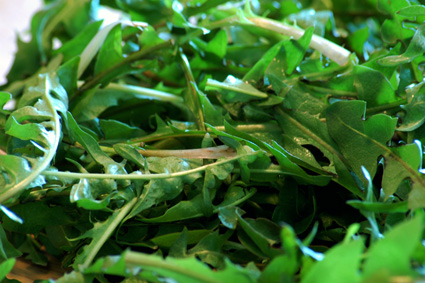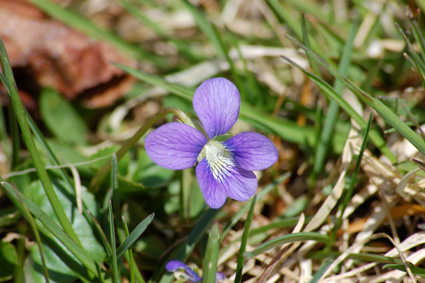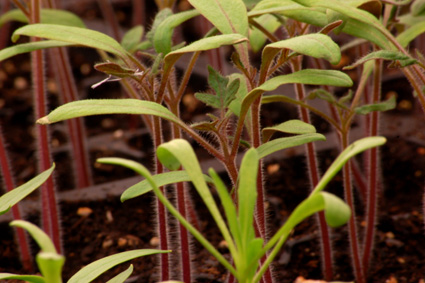Lewisburg.
Growing up, I used to think of dandelions as weeds. As far as my parents - and just about everyone else in the vast suburban sprawl - are concerned, they're plant pests that need to be dealt with. Often via a mysterious granular substance spread across the lawn every spring.
Now I think of dandelions as food. They're edible. Delicious. And both free and freely available from my untreated lawn and garden.

Right now is prime season for tender dandelion
1 greens, though the rapidly greening grass outside makes it somewhat more difficult to spot the bursts of little sawtooth leaves all around. Even so, it only takes ten or fifteen minutes of wandering about to fill the salad spinner, hardly making a dent in the total harvest out there. Those that I miss will go on to flower - I enjoy eating the flowers, too - and then there's always the opportunity to dig and roast the roots for making chicory "coffee".
2The leaves are just a tad bitter these days. Not so bitter that I can't enjoy eating some raw, but a salad of them exclusively is toeing the line. Ruth, who gave me some
hop rhizomes, likes that edge of bitterness tamed with a classic bacon dressing, though she admitted she's having difficulties finding a suitable replacement for her vegetarian husband. I have the same trouble: Sharon doesn't go for bacon. Also, she's less enthused by the leafy bitterness than I am.
Instead, I took an approach more like Mark Bittman mentioned
a few weeks back. His take was a Ligurian dish mixing dandelion (or other) greens with mashed potatoes, which do indeed look good. Except that we're all out of mashing potatoes - and only have about one meal's worth of fingerlings left, anyhow.
So: tortelloni.
3The key is to blanch the greens first. A minute in plenty of boiling, salted water completely eliminates any trace of bitterness, leaving sweet, wilted leaves that taste unmistakably of dandelion. Sure, a little bit like spinach - in the same way that all greens "taste like spinach" or all mild meats "taste like chicken" - but different and wonderful for it. Out of the boiling water, into cold water, and then drained and squeezed of excess moisture, they're ready to go.
I chopped them coarsely, mixed in about half as much ricotta, and added a few ground walnuts that were left over from a batch of
walnut brandy truffles two weeks ago. Just salt and black pepper for seasoning. The ricotta held it all together and gave the filling a bit of creaminess, but nothing masked the dandelion flavor (or color).
Wrapped in a bit of egg pasta dough, they've got a rustic sort of prettiness:

Since I wasn't sure how Sharon would react - turns out she loved 'em - I didn't build dinner entirely around them. Instead, I cooked them in a lightly seasoned duck stock
4, and served them with their broth. Topped with some grated Parmigiano and some finely minced wild onion greens.
Also from the backyard. Also a fine edible plant I'd grown up thinking of as a noxious weed.
* * * * *
1I'm sure that I've picked plenty of chicory leaves, too. They're similar in appearance, and pretty much interchangeable as far as flavor goes.
2Haven't done that yet, but I'm looking forward to trying it.
3Tortellini, the really little ones, seem like far too much effort for a more-pasta/less-filling alternative.
4Duck bones being in the handiest stock-makings bag in the freezer, of course, but it seemed a good enough idea that I decided to cook up a pair of duck breasts I found in there, too.








